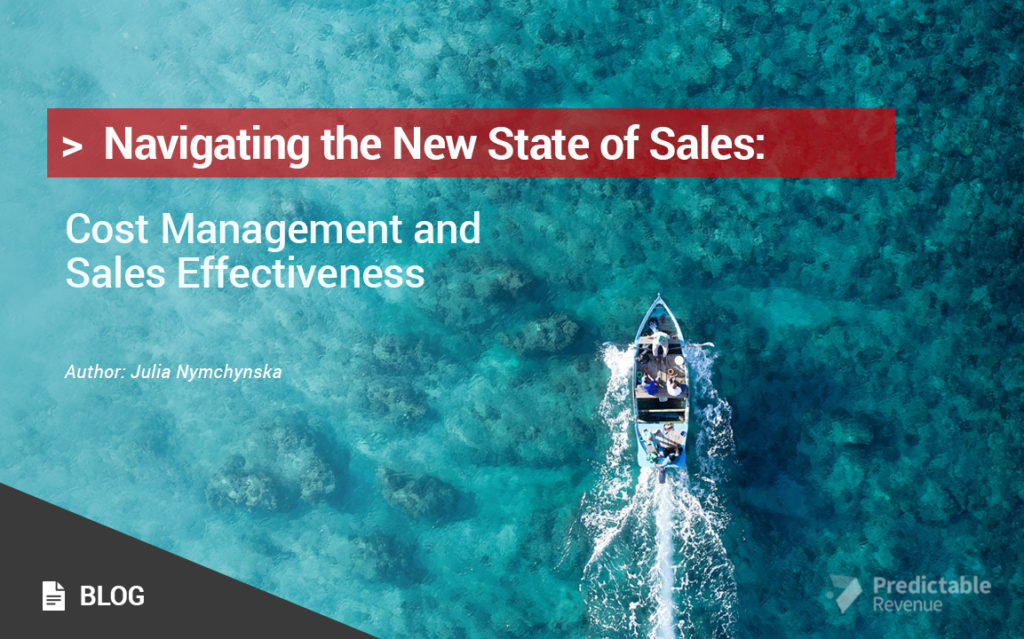Navigating the New State of Sales: Cost Management and Sales Effectiveness

Author: Julia Nymchynska
Sales teams around the world have undergone a massive disruption in recent months.
Due to the impact of the COVID-19 pandemic, events have been canceled, face-to-face demonstrations are a thing of the past, and consumer spending is dropping. The result has been panic, confusion, and demand for sudden change in almost every sales team.
During these times of uncertainty, it’s tempting for many business leaders to take a defensive approach to protecting their bottom line. In other words, you might plan on reducing your budget in every way possible to reduce your risk.
However, failing to maintain sales strategies could jeopardize your long-term objectives for growth and put you back behind the starting line when the marketplace recovers.
So, what can you do?
Balancing Cost Reductions and Sales Performance
According to Gartner, today’s Chief Sales Officers (CSOs) are likely to revaluate how and where they’re spending their money. Around 80% of team leaders say that they expect to face financial pressure in the next 12 months.
However, Gartner also warns that teams that react too quickly to the current marketplace could struggle to survive. If you want to protect your cash flow in this trying time, but also ensure that you have the right foundations in place for growth in the future, then you need to take a strategic approach to cost and team optimization.
Now is the time to craft a strategy that will maximize your impact as a growing organization, sustain current sales opportunities, and boost your chances of new pathways in the future.

Step 1: Find the right customers
The first step in cost optimization and sales enhancement, is ensuring that you’re spending your cash on the right leads and targets.
As any business leader knows, some leads are more likely to drive positive sales numbers than others. During this time of panic, it’s essential to know who your most valuable clients are, and how you can maximize your work with them.
For instance, with the right sales engagement technology and CRM services, you can examine the information that you’ve gathered about your leads over the years, and check things like:
- How much each client is likely to spend based on previous transactions
- How far along your team might be in closing the sale
- How many engaged and disengaged people are involved in that sale
Now is the perfect time to get hyper invested in the data that you have about your potential customers and what they need from you. Once you know who your most appealing leads are, work on finding ways to deliver more value to those customers. For instance, could you speed them along in the buyer journey by hosting a virtual demo, instead of waiting for a meeting in person?
If you’ve already made a successful sale to a lead, could you build your revenue while keeping costs low by up-selling with similar offers and complementary products? The probability of selling to an existing customer is 60-70%, while the possibility of selling to new prospects is 5-20%.
Step 2: Benchmark Current Spend and ROI
Improving the performance of your sales team, while reducing costs means thinking about what you’re already doing to encourage sales, and how much of an ROI you’re getting. Data is the key to effective optimization, so make sure that you collect as much of it as possible to help you make your future decisions. For instance:
a) How much does it cost to reach your current customers? Are you spending a lot of money on ads in social media that don’t always reach their target? If so, you might need to consider changing your strategy and using a different avenue, or customer persona.
b) Which of your sales tactics are most effective? If you have a series of playbooks that your team members use to connect with prospects, which ones are delivering the best return in this current landscape? Can you remove old playbooks and deliver training to make your team more efficient in new methods? A sales pipeline tool will help you to track this.
c) Which of your team members get the best results: Which of your sales experts are constantly getting the best return when it comes to closed deals and sales? Is there a tactic that these people use that you can share with the rest of the team?
Obtaining a complete overview of every aspect of your sales pipeline, team strategy, and processes will help you to eliminate any friction points that could be increasing your spend or reducing your chances of success.
Step 3: Provide the Right Guidance
In this new sales landscape, where many companies are forced to operate using different strategies, it’s essential that you have the right processes in place to support your team.
For instance, if your employees are used to using face-to-face demonstrations to convince customers to buy, then you might need to provide additional training on how to use webinar and video conferencing tools to access the same results in a virtual world.
With the right technology, business leaders can even create automated playbooks that remind team members when they need to follow up on prospects, or take the next step in a deal. This automation process is particularly useful in the remote working environment, where sales leaders might have a harder time keeping track of every individual sales team.
Remember, aside from providing helpful playbook guidance, today’s team leaders will also need to make sure that they’re available to answer any questions that their sales teams have. Integrating tools for collaboration into your workflow, like Microsoft Teams or Slack, will ensure that you can maintain a consistent conversation with your team. That way, process won’t be hampered when employees are waiting for feedback via email.

Step 4: Stay Agile
Finally, if the COVID-19 pandemic has proven anything, it’s that we all need to be prepared. Unexpected events can arise and transform the way that we sell in a matter of moments.
Although this pandemic has been an incredibly disruptive factor for many companies, it has also been a chance to learn and grow. You’ve had an opportunity to explore new paths to market, and experiment with different styles of selling.
As we continue to move into the future and begin to return to the workplace in the years to come, it’s important to learn from these experiences and use them to stay agile. The sales team that can adapt and shift according to the needs of the marketplace and customer will always be the one that accesses the best return on investment, with the lowest initial cost.
Stay on Top of Your Sales
Whether you’re planning your return to the office, or continuing to sell in a complex new environment, this isn’t the time to cut costs and corners. If you want to continue growing, you need a strategy that will allow you to earn continued sales, without overspending. Use the tips above to guide you, and continue to take advantage of these expanding opportunities for growth.
Julia loves all things innovation, productivity, and tech. Currently, she’s helping companies increase their ROE (Return on Customer Engagement) at revenuegrid.com
Experience and a lot of testing have shown us that it is possible to create email templates that people actually resonate with.
You don’t have to figure it out alone, whether you’re starting off as a sales representative, looking to improve your game or providing your team with expert advice, we have your back!